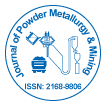Advancements in Sintering Techniques: Optimizing Materials for Tomorrow's Applications
Received: 03-Jan-2024 / Manuscript No. jpmm-24-141168 / Editor assigned: 05-Jan-2024 / PreQC No. jpmm-24-141168(PQ) / Reviewed: 19-Jan-2024 / QC No. jpmm-24-141168 / Revised: 24-Jan-2024 / Manuscript No. jpmm-24-141168(R) / Published Date: 31-Jul-2024 DOI: 10.4172/2168-9806.1000394 QI No. / jpmm-24-141168
Abstract
Sintering techniques play a pivotal role in modern manufacturing, enhancing the properties of powdered materials through controlled heating and densification processes. This case study explores recent advancements in sintering technologies, their applications across industries, and their impact on material performance and efficiency. Key topics include different sintering methods, innovations in process control, and the development of advanced materials for high-performance applications.
Keywords
Sintering techniques; Powder metallurgy; Material densification; Advanced ceramics; Process control.
Introduction
Sintering is a fundamental process in powder metallurgy and ceramics, where powdered materials are consolidated and transformed into solid objects through controlled heating and densification under controlled atmosphere or pressure [1,2]. This process is essential for achieving desired mechanical, thermal, and electrical properties in materials used across industries such as automotive, aerospace, electronics, and biomedical engineering.
Methods and Techniques
Several sintering techniques are employed based on the specific properties and requirements of the materials:
- Conventional Sintering: Involves heating the powdered materials to a temperature below their melting point to facilitate bonding and densification. This method is widely used for metals and ceramics in various applications [3-5].
- Spark Plasma Sintering (SPS): Utilizes pulsed direct current to rapidly heat and consolidate materials, resulting in superior densification and grain growth control. SPS is favoured for processing advanced ceramics, composites, and materials requiring precise microstructural control.
- Hot Isostatic Pressing (HIP): Applies high temperature and pressure simultaneously to achieve near-net shape parts with uniform density and enhanced mechanical properties. HIP is crucial for aerospace and biomedical applications where structural integrity and reliability are paramount.
- Selective Laser Sintering (SLS): A form of additive manufacturing where powdered materials are selectively sintered layer by layer using a laser beam. SLS enables rapid prototyping and customization of parts with complex geometries, revolutionizing manufacturing in industries like automotive and consumer goods.
Applications and Case Studies
- Automotive: High-performance engine components and lightweight structural parts benefit from sintering processes, enhancing fuel efficiency and reliability [6,7].
- Aerospace: Advanced materials processed through HIP and SPS ensure components withstand extreme conditions of aerospace applications, including high temperatures and mechanical stresses.
- Electronics: Miniaturization and enhanced functionality of electronic devices are achieved through precise control of material properties using sintering techniques.
- Biomedical Engineering: Sintered materials play a critical role in medical implants and prosthetics, offering biocompatibility and durability required for long-term implantation.
Sintering techniques have enabled ground-breaking advancements in various industries:
Challenges and Future Directions
Despite its advantages, sintering faces challenges such as ensuring uniform densification, minimizing defects, and optimizing energy efficiency. Future research aims to address these challenges through innovations in process modeling, advanced materials development, and integration with digital technologies for real-time process monitoring and control [8].
Discussion
Sintering techniques are fundamental processes in materials science and manufacturing, crucial for transforming powdered materials into solid objects with desired properties. This discussion explores the significance of sintering techniques, their applications across industries, advancements, challenges, and future directions [9,10].
Conclusion
In conclusion, sintering techniques continue to evolve, driving innovation and expanding the capabilities of materials science and manufacturing. By harnessing the potential of various sintering methods, industries can achieve superior material performance, optimize production processes, and meet the demands of increasingly complex applications. As research and technology advance, the future promises even more efficient and sustainable sintering processes, further enhancing the role of sintering in shaping the materials of tomorrow.
References
- Kaur A, Sharma MP, Chaturvedi SK (2021) Felt needs of cancer palliative care professionals working in India: A qualitative study. Indian J Palliat Care 27:544-551.
- Den Hartogh G (2017) Suffering and dying well: on the proper aim of palliative care. Med Health Care Philos 20:413-424.
- Brondeel KC, Duncan SA, Luther PM, Anderson A, Bhargava P, et al. (2023) Palliative Care and Multi-Agent Systems: A Necessary Paradigm Shift. Clin Pract 13:505-514.
- Alva H, Sequeira AH, Narayana VN (2023) Proactive Approach to Palliative Care through Routine Monitoring by Home Caregivers Using Multiagent Systems: A Conceptual Framework. Int J Eng Sci Technol 9:708-712.
- Ahmed Kamal M, Ismail Z, Shehata IM, Djirar S, Talbot NC, et al. (2023) Telemedicine, E-Health, and Multi-Agent Systems for Chronic Pain Management. Clin Pract 13:470-482.
- Karabulutlu EY, Turan GB, Yanmıs S (2022) Evaluation of care burden and preparedness of caregivers who provide care to palliative care patients. Palliat Support Care 20:30-37.
- Jeba J, Ponissery J, Ramaswamy A, Johnson JR, Thelly AS, et al. (2020) Developing evidence-based clinical guidelines in palliative care for home care setting in India Indian. J Palliat Care 26:319-322.
- Bruera E (2004) The development of a palliative care culture. J Palliat Care 20:316-319.
- Wajid M, Rajkumar E, Romate J, George AJ, Lakshmi R, et al. (2021) Why is hospice care important? An exploration of its benefits for patients with terminal cancer. BMC Palliat Care 20:70.
- Kaur D, Kumar G, Billore N, Singh AK (2016) Defining the role of physiotherapy in palliative care in multiple sclerosis. Indian J Palliat Care 22:176-179.
Indexed at, Google Scholar, Crossref
Indexed at, Google Scholar, Crossref
Indexed at, Google Scholar, Crossref
Indexed at, Google Scholar, Crossref
Indexed at, Google Scholar, Crossref
Indexed at, Google Scholar, Crossref
Indexed at, Google Scholar, Crossref
Citation: Anish C (2024) Advancements in Sintering Techniques: Optimizing Materials for Tomorrow's Applications. J Powder Metall Min 13: 394. DOI: 10.4172/2168-9806.1000394
Copyright: © 2024 Anish C. This is an open-access article distributed under the terms of the Creative Commons Attribution License, which permits unrestricted use, distribution, and reproduction in any medium, provided the original author and source are credited.
Share This Article
Recommended Journals
Open Access Journals
Article Tools
Article Usage
- Total views: 463
- [From(publication date): 0-2024 - Apr 21, 2025]
- Breakdown by view type
- HTML page views: 261
- PDF downloads: 202
